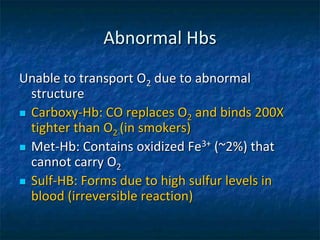hb.ppt
- 1. Structure and function of hemoglobin GIT | 1 Lecture | Dr. Usman Ghani
- 2. Hemoglobin (Hb) A hemeprotein found only in red blood cells Oxygen transport function Contains heme as prosthetic group Heme reversibly binds to oxygen
- 3. The heme group A complex of protoporphyrin IX and ferrous iron (Fe2+) Fe2+ is present in the center of the heme Fe2+ binds to four nitrogen atoms of the porphyrin ring Forms two additional bonds with: Histidine residue of globin chain Oxygen
- 4. The heme group: Fe2+– porphyrin complex with bound O2
- 5. Types of Hb Normal: HbA (97%) HbA2 (2%) HbF (1%) HbA1c Abnormal: Carboxy Hb Met Hb Sulf Hb
- 6. Hemoglobin A (HbA) Major Hb in adults Composed of four polypetide chains: Two α and two β chains Contains two dimers of ab subunits Held together by non-covalent interactions Each chain is a subunit with a heme group in the center that carries oxygen A Hb molecule contains 4 heme groups and carries 4 moelcules of O2
- 9. T-form of Hb The deoxy form of Hb Taut form The movement of dimers is constrained Low-oxygen-affinity form
- 10. R-form of Hb The oxygenated form of Hb Relaxed form The dimers have more freedom of movement High-oxygen-affinity form
- 11. Hemoglobin function Carries oxygen from the lungs to tissues Carries carbon dioxide from tissues back to the lungs Normal level (g/dL): • Males: 14-16 • Females: 13-15
- 12. Factors affecting oxygen binding Three allosteric effectors: pO2 (partial oxygen pressure) pH of the environment pCO2 (partial carbon dioxide pressure) Availability of 2,3-bisphosphoglycerate
- 13. Oxygen Dissociation Curve The curve is sigmoidal Indicates cooperation of subunits in O2 binding Binding of O2 to one heme group increases O2 affinity of others Heme-heme interaction
- 14. P50 Indicates affinity of Hb to O2 P50(mm Hg): the pressure at which Hb is 50% saturated with O2 High affinity slow unloading of O2 Low affinity fast unloading of O2 Lung pO2 is 100 mm Hb saturation 100% Tissue pO2 is 40 mm Hb saturation reduces Hence O2 is delivered to tissues
- 16. The Bohr effect Effect of pH and pCO2 on: Oxygenation of Hb in the lungs Deoxygenation in tissues Tissues have lower pH (acidic) than lungs Due to proton generation: CO2 + H20 HCO3 - + H+ Protons reduce O2 affinity of Hb
- 17. The Bohr Effect Causing easier O2 release into the tissues The free Hb binds to two protons Protons are released and react with HCO3 – to form CO2 gas (HCO3 - + H+CO2 + H20 ) The proton-poor Hb now has greater affinity for O2 (in lungs) The Bohr effect removes insoluble CO2 from blood stream Produces soluble bicarbonate
- 18. Availability of 2,3 bisphosphoglycerate Binds to deoxy-hb and stabilizes the T-form When oxygen binds to Hb, BPG is released At high altitudes: -RBC number increases -Hb conc. increases -BPG increases
- 19. High altitude and O2 affinity In hypoxia and high altitude 2,3 BPG levels rise This decreases O2 affinity of Hb Thus increases O2 delivery to tissues
- 20. High O2 affinity High O2 affinity is due to: Alkalosis High levels of Hb F Multiple transfusion of 2,3 DPG-depleted blood
- 21. Low affinity to O2 High affinity to O2
- 22. Fetal Hemoglobin (HbF) Major hemoglobin found in the fetus and newborn Tetramer with two a and two g chains Higher affinity for O2 than HBA Transfers O2 from maternal to fetal circulation across placenta
- 23. HbA2 Appears ~12 weeks after birth Constitutes ~2% of total Hb Composed of two a and two d globin chains
- 24. HbA1c HbA undergoes non- enzymatic glycosylation Glycosylation depends on plasma glucose levels HbA1c levels are high in patients with diabetes mellitus
- 25. Abnormal Hbs Unable to transport O2 due to abnormal structure Carboxy-Hb: CO replaces O2 and binds 200X tighter than O2 (in smokers) Met-Hb: Contains oxidized Fe3+ (~2%) that cannot carry O2 Sulf-HB: Forms due to high sulfur levels in blood (irreversible reaction)


























